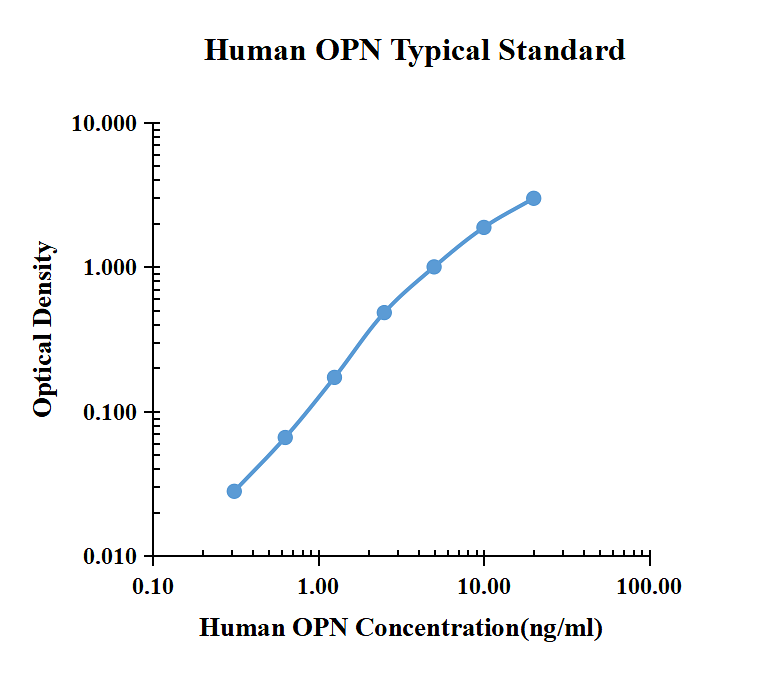Human Osteopontin(OPN) enzyme-linked immunoassay kit
| Specification | 96 Test |
|---|---|
| Sensitivity | 0.04 ng/ml (50 μl);0.12 ng/ml (10 μl) |
| Standard Curve Range | 0.31~20 ng/ml |
| Standard Curve Gradient | 7 Points |
| Number of Incubations | 2 |
| Detectable sample | Liquid phase sample of soluble substances. For example: serum, plasma, cell culture supernatant, tissue grinding liquid, etc. |
| Sample Volume | 50 μl/10 μl |
| Type | Fully Ready-to-Use |
| Operation Duration | 120min |

| ng/ml | O.D. | Average | Corrected | |
|---|---|---|---|---|
| 0.00 | 0.0246 | 0.0244 | 0.0245 | |
| 0.31 | 0.0543 | 0.0502 | 0.0523 | 0.0278 |
| 0.63 | 0.0937 | 0.0866 | 0.0902 | 0.0657 |
| 1.25 | 0.2017 | 0.1903 | 0.1960 | 0.1715 |
| 2.50 | 0.5132 | 0.5027 | 0.5080 | 0.4835 |
| 5.00 | 1.0570 | 0.9935 | 1.0253 | 1.0008 |
| 10.00 | 1.9270 | 1.8780 | 1.9025 | 1.8780 |
| 20.00 | 3.0580 | 2.9620 | 3.0100 | 2.9855 |
Precision
| Intra-assay Precision | Inter-assay Precision | |||||
| Sample Number | S1 | S2 | S3 | S1 | S2 | S3 |
| 22 | 22 | 22 | 6 | 6 | 6 | |
| Average(ng/ml) | 0.42 | 2.09 | 6.22 | 0.51 | 2.10 | 6.03 |
| Standard Deviation | 0.02 | 0.09 | 0.48 | 0.02 | 0.10 | 0.37 |
| Coefficient of Variation(%) | 4.9 | 4.5 | 7.7 | 4.3 | 4.7 | 6.1 |
Intra-assay Precision (Precision within an assay) Three samples of known concentration were tested twenty times on one plate to assess intra-assay precision.
Inter-assay Precision (Precision between assays) Three samples of known concentration were tested six times on one plate to assess intra-assay precision.
Spike Recovery
The spike recovery was evaluated by spiking 3 levels of human OPN into health human serum sample. The un-spiked serum was used as blank in this experiment.
The recovery ranged from 83% to 117% with an overall mean recovery of 108%.
Sample Values
| Sample Matrix | Sample Evaluated | Range (ng/ml) | Detectable (%) | Mean of Detectable (ng/ml) |
|---|---|---|---|---|
| Serum | 30 | 1.1-6.74 | 100 | 3.97 |
Serum/Plasma – Thirty samples from apparently healthy volunteers were evaluated for the presence of OPN in this assay. No medical histories were available for the donors.
Product Data Sheet
Background: OPN
Osteopontin (OPN), also known as bone sialoprotein (BSP), is a secreted SIBLING family protein that can be variably modified by O- and N-glycosylation, sulfation, phosphorylation, and transglutamination. OPN is widely expressed and is prominent in mineralized tissues. It inhibits bone mineralization and kidney stone formation and promotes inflammation, cell ad¬hesion, and migration. Its expression is upregulat¬ed during inflammation, obesity, atherosclerosis, cancer, and tissue damage and contributes to the pathophysiology of these conditions. The central region of OPN contains RGD and non-RGD binding sites for multiple integrins. Adjacent to the RGD motif is the sequence SLAYGLR (SVVYGLR in human) which serves as a cryptic binding site for additional integrins: it is masked in full length OPN but is exposed following OPN cleavage by multiple proteases in tumors and sites of tissue injury.

